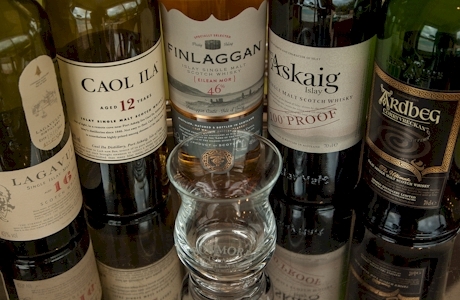WHISKEY TASTING TERMS and SOURCES
By Steve Kirwan
Understanding the language of whiskey enhances its enjoyment. The experience of sampling is informed by the senses: taste, smell, and to some degree, touch. Although sensory perception is subjective, the industry has widely accepted descriptors. Most are self-explanatory and transcend whiskey origin and type, but some are abstract and jargonistic. The Scotch Whisky Research Institute (previously “Pentlands Scotch Whisky Research”) standardized the most commonly used terms, and despite applying specifically to Scotch whisky, they’re equally applicable to all types of whiskey (Scotch, Irish, American, Japanese, Malt, Bourbon, Rye, etc.). See the lower half for more on the science and sources of whiskey aromas and flavors.
ABSTRACT DESCRIPTORS
Here are a few of the most frequent:
- Bland: Lacking in distinctive characteristics
- Coarse: Flavors or aromas that are harsh or overly intense
- Clean: Free of imperfections
- Dry: Lacking in sweetness, astringent
- Flat: Dull, boring, lacking complexity
- Fresh: Full of flavor, no offputting characteristics
- Green: Leafy or floral (from aldehyde)
- Hard: Strong metallic or flinty sensations;
- Harsh: Highly astringent or sharp
- Heavy: Intense aromas and flavors
- Light: Delicate, but well-defined aromas and flavors
- Mellow: Smooth and soft, minimal alcohol sensation
- Neutral: Lacking aromas other than alcohol
- Rich: Fullness, roundness, oiliness, intensity, pleasantly sweet aromas
- Round: Balanced aromas, flavors, and mouthfeel
- Robust: Intense aroma, full-flavored, and powerful character
- Sharp: High alcohol, acidity, or astringency
- Soft: Subtle aromas and flavors
- Sweet: Aromas and flavors of sweet malted barley
- Thin: Diluted or watery mouth-feel; lacks aroma and flavor
COMPARATIVE DESCRIPTORS
There are also hundreds of concrete comparative terms to describe the flavors and aromas of whiskey, including:
- fruity, dried fruit, fresh fruit, citrus, melon, lemon, lime, orange, peach, plum, cherry, berry, apple, green apple, pear
- cranberry, tart cherry, currant
- sweet, cake, fruit cake, candied cherries, craisins
- figs, raisins, prunes, dates, dried apricots, bananas
- flowery, rosewater, rose petals, fragrant, perfume, meadow, violets
- herbal, savory, esters
- vegetal, grassy, leafy, clover, laurel, eucalyptus,
- peat, earth, heath, heather, moor, fen, cedar, silage, hay, cut grass, musty, moss, wet dog
- butter, oily, fatty, greasy
- chocolate, cocoa, malted milk
- smoke, charred, charcoal, burnt, fireplace, campfire
- woody, oak, cask, tannic, rope
- spicy, warmth, hot, zesty, fiery
- spiced, cinnamon, nutmeg, cloves, vanilla, anise
- tea, coffee
- pine, resin, sap
- sherry, oloroso, wine, red wine, rum, port, liqueur
- malty, grain, cereal, toast, bread, shortbread, cookies, biscuits, oatmeal
- nutty, almond, walnuts, coconut
- candy, toffee, butterscotch, caramel, marshmallow
- seaside, seaweed, salt, kelp, kippers, brine, ocean
- tobacco, pipe tobacco, cigar box, leather
- honey, syrup, maple, molasses,
- alcohol burn, ethanol, spirity
- medicinal, iodine, solvent, turpentine
- sulphuric, creosote, tar, phenolic, tarry rope
- bitter, astringent, dry, tart, acidic
- balanced, nuanced, complex, clean, subtle
- heavy, smooth, creamy, full-bodied, rich
- lasting, long, short
THE SOURCES OF WHISKEY AROMAS AND FLAVORS
The preparation of raw materials and subsequent distillation determine a whiskey’s primary characteristics. The grain or grains used, whether malted or unmalted, how dried (peated or not), the yeast used for fermentation, and any water used for dilution, all can dramatically impact the results.
Once distilled, the raw whiskey spends a legally set minimum time in wood barrels for maturation, the specifics set by law for each whiskey type. The cask and its prior contents impart unique aromas, flavors, and color to the whiskey, making casking choices a critical decision for creating different expressions. Casks may include new American or French oak, or used (ex-fill) bourbon, rum, sherry, chardonnay, port, red wine, or other barrels. Particularly common with Scotch, experimentation with different kegs is limited only by the producer’s imagination. Many producers start aging in one type of cask and finish in another. The terms “single barrel,” “double matured,” or “double” or “triple-wood” (or similar) reflect such casking variations. Extended aging usually results in smoother whiskeys with more intense cask-induced flavors and a commensurately higher price.
AROMA CHEMISTRY
The tiers listed below represent aroma terms ranging from the most general (first tier) to the most detailed (third tier). The proper way to use this chart is to start with the third tier and then move backward. Most categorization takes place in the second tier. The third tier is for specifying the aroma, the second tier is for generalized classification, and the first tier identifies the chemical source of the smells. As with most subjective analysis, the chart is neither comprehensive nor exhaustive. Keep in mind that we’ve included this section for scientists, production techs, whiskey nerds, and other propeller-heads!
KEY:
1st Tier: SOURCE
2nd Tier: CATEGORY
3rd Tier: DESCRIPTOR
- Aromas from the distillation process:
- SOURCE: Aldehydes
CATAGORY: Leafy, Floral
DESCRIPTOR: Dry hay, Coumarin, Mown hay, Green leaves, Grass cuttings, Geraniums, Green tomatoes, Violets - SOURCE: Esters
CATAGORY: Fruity, Fragrant, Solvent
DESCRIPTOR: Perfumed, Scented, Roses, Carnations, Scorched plastic
- SOURCE: Phenols
CATAGORY: Medicinal, Peaty, Kippery (fishy)
DESCRIPTOR: TCP, Iodine, Carbolic, Smokey, Creosote, Birch, Burned, Wood, Tar-like, Lox (pickled salmon)
- SOURCE: Aldehydes
- Aromas from the maturation process:
- SOURCE: Extractives
CATAGORY: Sherry, Bourbon
DESCRIPTOR: Ethyl alcohol, Burnt rubber, Vanilla-like, Scented, Paraffin-like, Rum-like, Brandy-like, Fruit pulp - SOURCE: Oily
CATAGORY: Nutty, Buttery, Fatty
DESCRIPTOR: Marzipan, Creamy, Soapy, Tallowy, Mutton fat - SOURCE: Sweet
CATAGORY: Honey, Vanilla
DESCRIPTOR: Custard, Treacle, Chocolate, Toffee - SOURCE: Woody
CATAGORY: Resinous, Sappy
DESCRIPTOR: Pine, Cedar
- SOURCE: Extractives

